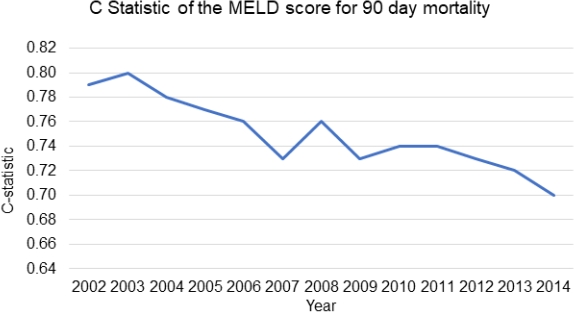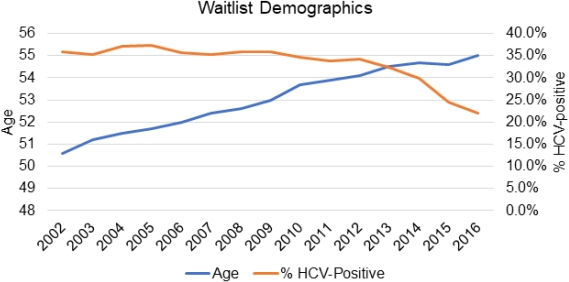The Predictive Power of MELD is Decreasing in the Era of Older, Sicker Patients
1Department of Surgery, Baylor College of Medicine, Houston, TX
2Department of Medicine, University of California, San Francisco, San Francisco, CA
3Department of Pediatrics, Baylor College of Medicine, Houston, TX.
Meeting: 2018 American Transplant Congress
Abstract number: 351
Keywords: Allocation, Liver, Prediction models, Waiting lists
Session Information
Session Name: Concurrent Session: Liver: MELD, Allocation and Donor Issues - 1
Session Type: Concurrent Session
Date: Monday, June 4, 2018
Session Time: 4:30pm-6:00pm
 Presentation Time: 4:30pm-4:42pm
Presentation Time: 4:30pm-4:42pm
Location: Room 6B
Purpose
The field of liver transplantation has shifted considerably in the MELD era. Liver allocation, immunosuppression, and etiologies of liver failure have changed over time, and better supportive therapies enable sicker patients to receive transplants. Our aim was to evaluate predictive accuracy of the MELD score over time.
Methods
The United Network for Organ Sharing provided de-identified data on 120,156 patients listed for liver transplant from 2002-2016. Candidates were categorized by age, MELD score, HCV status, and time of listing. The ability of MELD to predict 90-day mortality was evaluated by a concordance (C-) statistic.
Results
The ability of MELD to predict 90-day mortality has trended down from 0.80 in 2003 to 0.70 in 2014.  Percent of waitlisted patients transplanted declined from 49% in 2005 to 30% in 2016. While lab MELD scores at listing and transplant climbed in that same interval, score at death for patients that die on the waitlist remained steady at 28. Patient ages increased from 50 to 55 years. HCV-positive status at listing dropped from 35 to 22%.
Percent of waitlisted patients transplanted declined from 49% in 2005 to 30% in 2016. While lab MELD scores at listing and transplant climbed in that same interval, score at death for patients that die on the waitlist remained steady at 28. Patient ages increased from 50 to 55 years. HCV-positive status at listing dropped from 35 to 22%.  The concordance of MELD and mortality does not differ with age (>60 = 0.744, < 60 = 0.747) but is higher in HCV-positive patients (HCV positive= 0.76; negative = 0.74).
The concordance of MELD and mortality does not differ with age (>60 = 0.744, < 60 = 0.747) but is higher in HCV-positive patients (HCV positive= 0.76; negative = 0.74).
Conclusions
While MELD remains predictive of mortality, its accuracy has decreased since 2002; decreasing rate of HCV infection in listed individuals may contribute to this effect. The waitlist population has steadily increased in age and liver disease severity since 2002, and a smaller proportion of listed individuals receive transplants.
CITATION INFORMATION: Godfrey E., Lai J., Miloh T., Galvan N., Cotton R., O'Mahony C., Vierling J., Sussman N., Rana A. The Predictive Power of MELD is Decreasing in the Era of Older, Sicker Patients Am J Transplant. 2017;17 (suppl 3).
To cite this abstract in AMA style:
Godfrey E, Lai J, Miloh T, Galvan N, Cotton R, O'Mahony C, Vierling J, Sussman N, Rana A. The Predictive Power of MELD is Decreasing in the Era of Older, Sicker Patients [abstract]. https://atcmeetingabstracts.com/abstract/the-predictive-power-of-meld-is-decreasing-in-the-era-of-older-sicker-patients/. Accessed January 6, 2026.« Back to 2018 American Transplant Congress
